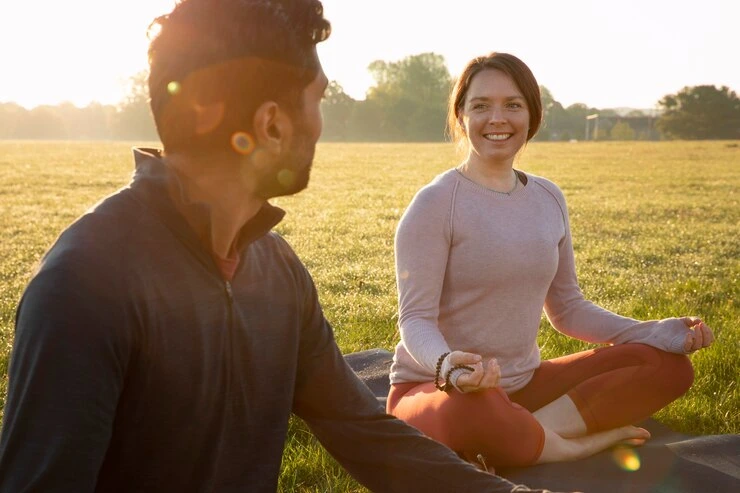Have you ever been in a conversation with your partner, but your mind was a million miles away—rehashing a work problem or planning your to-do list? We’ve all been there. It’s easy to fall into autopilot mode, especially with the people we’re most comfortable with. But what if we chose to be fully present? That’s the core of a mindful relationship. It’s about bringing your entire attention to your interactions, responding with intention instead of reacting from habit. If you’re new to this idea, learning what is mindfulness is a great first step. This approach can reshape how you communicate, handle disagreements, and build real intimacy. Studies have even shown that couples who practice mindfulness together feel more satisfied and connected in their relationships.
What Are Mindful Relationships?
At its heart, a mindful relationship is one where you and your partner commit to being fully present with each other. It means putting down the phone, tuning out distractions, and seeing your partner for who they are in this moment, not through the filter of yesterday’s arguments or tomorrow’s worries.
Instead of running on autopilot, you actively engage with conscious awareness. This means you learn to observe your own thoughts and emotions without letting them hijack your behavior. That little pause creates enough space to choose a kind, intentional response over a knee-jerk reaction. This practice, rooted in ancient traditions, has been adapted to help modern couples navigate the complexities of life together.
The Connection Between Mindfulness and Relationships
So how does sitting quietly and paying attention actually help a relationship? It works by directly improving the skills needed for a strong partnership. When you practice mindfulness, you get better at emotional regulation. You learn to notice feelings like anger or frustration without immediately acting on them. This calms the body’s stress response, which is often what turns a simple disagreement into a full-blown fight.

There’s even a bit of science to it. Being mindfully present with someone can trigger the release of oxytocin—often called the “love hormone”—which helps build trust and strengthens your bond. Research consistently shows a strong link between mindfulness and higher relationship quality, as it fosters the empathy and clear communication every partnership needs to thrive.
Why Traditional Relationships Struggle Without Mindfulness
Without mindful awareness, it’s easy to fall into common traps. Think about the last time you had a disagreement. Did you find yourself planning your rebuttal while your partner was still talking? That’s a classic example of poor listening.
Other common issues include:
- Automatic Defensiveness: Reacting to feedback as a personal attack rather than listening to the underlying concern.
- Judgment and Criticism: Automatically finding fault instead of trying to understand your partner’s perspective.
- Escalating Conflicts: Letting unmanaged emotions pour fuel on the fire until the original issue is forgotten.
Often, we drag our past experiences and assumptions into the present, leading to misunderstandings. Mindfulness helps us put that baggage down and interact with what’s happening right now.
The Benefits of Mindful Relationships
Bringing mindfulness into your relationship isn’t just about reducing conflict; it’s about increasing joy, connection, and understanding. The research-backed benefits touch every part of your partnership, from everyday conversations to your deepest emotional bonds. You’ll see improvements in how you communicate, connect emotionally, solve problems, and grow as individuals.
Enhanced Communication and Active Listening
Mindful communication is about listening with your whole being. It means you aren’t just hearing words; you’re paying attention to tone, body language, and the emotions behind them. When your partner speaks, you give them your full focus, resisting the urge to interrupt or formulate your counterargument.
This simple shift creates a sense of safety where you both feel truly heard and respected. A few techniques include:
- Maintaining soft, gentle eye contact.
- Nodding or leaning in to show you’re engaged.
- Asking clarifying questions like, “What I hear you saying is… is that right?”
Improved Emotional Regulation
Mindfulness is like building a muscle for emotional balance. It gives you the ability to pause between a feeling and your reaction to it. That pause is everything. It’s the space where you decide not to say something hurtful in the heat of the moment.
You also become more aware of the physical signs of your emotions. You might notice your chest tightening or your jaw clenching when you start to feel angry. Recognizing these cues early gives you a chance to take a deep breath and calm down before the conflict escalates.
Deeper Emotional Intimacy and Connection
True intimacy is built on feeling seen, heard, and understood. When you are fully present with your partner, you create a space for vulnerability and authenticity. This is where real connection happens. You start to tune into each other’s emotional states more easily.
Practicing gratitude also plays a huge role. By mindfully appreciating your partner, you strengthen your bond and focus on what’s good in the relationship. It’s about creating a safe harbor where you both can share your true selves without fear of judgment.

Better Conflict Resolution
No relationship is without conflict, but mindfulness changes how you navigate it. Instead of seeing a disagreement as a battle to be won, you can approach it as a problem to be solved together. Mindful awareness helps you stay calm and centered, even when discussing difficult topics.
Instead of getting defensive, you can listen to understand your partner’s viewpoint. Taking a few mindful breaths during a tense conversation can make a world of difference. The goal shifts from winning the argument to preserving the connection.
Increased Empathy and Understanding
Empathy is the ability to step into your partner’s shoes and see the world from their perspective. Mindfulness cultivates this skill by teaching non-judgmental awareness. You learn to observe your partner’s behavior with curiosity rather than criticism.
Instead of blaming them for their reaction, you might wonder, “What are they feeling that’s causing them to say that?” This simple shift from judgment to curiosity can diffuse tension and open the door to compassionate dialogue.
Essential Mindful Relationship Practices
Ready to try it out? These are practical, simple strategies you can start using today. Remember, you don’t have to wait for your partner to join in. Even if you’re the only one practicing, your new approach will positively influence your interactions. Of course, learning how do i practice mindfulness together can amplify the benefits.
Practice Present Moment Awareness
This is the foundation. When you spend time together, be there. Put your phones away. Turn off the TV. Anchor yourself in the present moment by focusing on your breath or the physical sensation of holding your partner’s hand. When you notice your mind wandering—and it will—gently guide it back to the here and now.
Cultivate Non-Judgmental Observation
This is about noticing your thoughts without letting them rule you. When a critical thought about your partner arises, just observe it. You don’t have to believe it or act on it. For example, instead of thinking, “They’re being so difficult,” you can reframe it with curiosity: “I wonder what’s going on for them right now?” This creates space for understanding instead of immediate reaction.
Engage in Mindful Communication
Mindful communication is clear, kind, and intentional.
- Use “I” statements: Say “I feel hurt when…” instead of “You always…”
- Pause before you speak: Take a breath and consider your intention. Are you trying to connect or to win?
- Reflect back what you hear: “It sounds like you felt really frustrated. Do I have that right?” This ensures you’re both on the same page.
Schedule Regular Emotional Check-Ins
Life gets busy, and important conversations can fall through the cracks. Set aside a regular time each week to check in with each other. This isn’t for solving problems; it’s for sharing and listening. Each of you can share:
- How you’re feeling emotionally.
- One challenge from the week.
- Something you’re grateful for in the relationship.
- One thing you need support with.
Listen without trying to fix anything. Just be present for each other.

Mindful Relationship Exercises for Couples
Practicing specific exercises together can strengthen your mindful connection. They might feel a little strange at first, but with repetition, they become powerful tools for intimacy.
Eye-Gazing Exercise
This one is simple but profound. Sit comfortably facing your partner, set a timer for 3-5 minutes, and maintain soft, gentle eye contact without talking. Your mind will wander, and you might feel awkward, but just keep returning your focus to your partner’s eyes. It builds vulnerability and connection in a way words can’t.
Loving-Kindness Meditation for Your Partner
This meditation cultivates feelings of warmth and compassion. You can practice it alone while thinking of your partner, or sit together and do it. Silently repeat phrases like:
- “May you be happy.”
- “May you be healthy.”
- “May you be safe.”
- “May you live with ease.”
Directing these well-wishes toward your partner helps soften resentment and deepens your sense of care. It’s a powerful form of how to do mindfulness meditation focused on another person.
Mindful Touch and Physical Connection
Touch is a powerful connector. Try holding hands and putting all of your attention on the sensation—the warmth, the texture, the pressure. Or, give your partner a short shoulder massage where you focus completely on the act of touching and they focus completely on receiving. This isn’t about sex; it’s about presence and connection through physical contact.
Gratitude Sharing Practice
Make it a daily or weekly habit to share one specific thing you appreciate about each other. Specificity is key. Instead of a generic “Thanks for being you,” try, “I really appreciated how you made me coffee this morning without me having to ask.” This practice trains your brains to notice the good in your relationship.
Synchronized Breathing Together
Sit or lie down together and consciously match your breathing. One person can set a slow, steady pace, and the other can gradually fall into the same rhythm. This is incredibly calming and creates a sense of physiological attunement. It’s a wonderful exercise to do before a difficult conversation or after an argument to reconnect. Many find that simple mindfulness breathing exercises like this one are a great entry point.

Navigating Challenges in Mindful Relationships
Being mindful in a relationship isn’t always easy. You’ll have moments where you forget, react out of habit, or feel frustrated. That’s perfectly normal. These challenges are part of the process, not signs of failure.
When Only One Partner Practices Mindfulness
What if you’re all in, but your partner is skeptical? Don’t worry. Your solo practice will still create positive change. When you show up calmer, more empathetic, and less reactive, the dynamic of your interactions naturally shifts. The key is to model the behavior without being preachy. Lead by example, and don’t be surprised if your partner eventually becomes curious about what you’re doing differently.
Managing Difficult Emotions and Conversations
It’s hard to stay mindful when you feel emotionally flooded. When you feel a strong emotion, try mentally naming it: “Ah, this is anger,” or “I’m noticing a lot of sadness.” This simple act creates a bit of distance and helps you feel less overwhelmed. It’s also okay to take a break. Agree on a signal or phrase to pause a heated conversation and return to it when you’re both calmer.
Maintaining Consistency in Practice
Consistency can be tough when life gets busy. The secret is to start small. Don’t aim for an hour of meditation a day. Maybe start with just one mindful breath before you respond in a conversation. Or try a three minute mindfulness exercise together. Anchor your practice to an existing habit, like sharing a gratitude moment over your morning coffee. Remember, it’s called a practice for a reason. Every time you get off track and gently bring yourself back, you are succeeding.
Building Long-Term Mindful Relationship Habits
Over time, mindfulness stops being something you do and becomes part of how you are in your relationship. It gets integrated into the fabric of your daily life, creating a strong foundation of presence and connection.

Creating Rituals and Routines
Rituals create predictable moments of connection that you can count on. These don’t have to be elaborate. They can be simple, sustainable habits that weave mindfulness into your day.
- Device-free dinners: Put phones away and focus on the food and conversation.
- Morning connection: Spend five minutes just talking over coffee before the day begins.
- Bedtime gratitude: Share one thing you’re thankful for before going to sleep.
Developing Shared Mindful Activities
Find activities you both enjoy that naturally promote mindfulness. This could be taking a quiet walk in nature, cooking a meal together, or even gardening. The activity itself matters less than the intention you bring to it. Sharing these present-moment experiences creates positive memories and strengthens your sense as a team.
Growing Together Through Self-Awareness
Ultimately, a mindful relationship is a journey of personal growth for both people. It requires you to understand your own triggers, patterns, and needs so you can show up as your best self. Being self-aware allows you to take responsibility for your reactions instead of blaming your partner. This ongoing growth is an act of love for yourself and your relationship.
Conclusion
Building a mindful relationship is a continuous practice of returning to the present moment, again and again. It’s not about being perfect, but about being intentional. By choosing presence over autopilot, listening over reacting, and curiosity over judgment, you can build a deeper, more resilient, and more joyful connection. It’s a journey worth taking, one breath at a time.
For more thoughts on wellness and conscious living, feel free to explore more at www.notonetype.org.
Frequently Asked Questions (FAQ)
1. What if my partner thinks mindfulness is silly or won’t participate?
That’s a common concern. The best approach is to lead by example. Focus on your own practice without pressure or expectation. When your partner sees you becoming calmer, a better listener, and less reactive, their curiosity may naturally grow. Your personal changes will positively impact the relationship regardless of their participation.
2. How long does it take to see changes in our relationship?
You might notice small changes very quickly, like catching yourself before a reactive comment. Deeper shifts, however, take time and consistent effort. The key is patience and celebrating small wins. Some couples feel a greater sense of calm and connection within a few weeks of practicing regularly.
3. Can mindfulness fix a deeply troubled relationship?
Mindfulness is a powerful tool for improving communication and connection, but it’s not a magic cure for all problems. For serious issues like deep-seated resentment, broken trust, or incompatible values, it can be a helpful supplement to professional couples therapy, but it may not be enough on its own.
4. We’re so busy. How do we find the time for these practices?
Start incredibly small. You don’t need to add an hour to your day. Begin by bringing mindfulness to things you already do. Have a mindful cup of coffee together for three minutes. Practice active listening during your commute home. Choose one small exercise, like sharing gratitude before bed, and make it a consistent habit.


You may also like this
Three Minute Mindfulness: Quick Practices to Ground Yourself Anywhere
Three minute mindfulness practices offer a practical way to stay grounded without needing extensive time...
Nov
Mindfulness Breathing Exercises: 15 Simple Techniques to Reduce Stress and Find Calm
Mindfulness breathing exercises offer a simple yet powerful way to reduce stress, calm your mind,...
Nov
Mindfulness at Work: A Practical Guide to Reducing Stress and Boosting Productivity
Have you ever finished a workday feeling completely drained, like you were busy all day...
Nov
How to Do Mindfulness Meditation: Step-by-Step Guide for Beginners
Mindfulness meditation has been a complete game-changer for me. It’s a simple yet incredibly powerful...
Nov
How to Practice Mindfulness: 8 Simple Techniques for Beginners
It’s easy to feel like life is constantly running on autopilot. We rush from one...
Nov
What Is Mindfulness: Definition, Benefits, and How to Practice Daily
Mindfulness is the basic human ability to be fully present, aware of where you are...
Nov